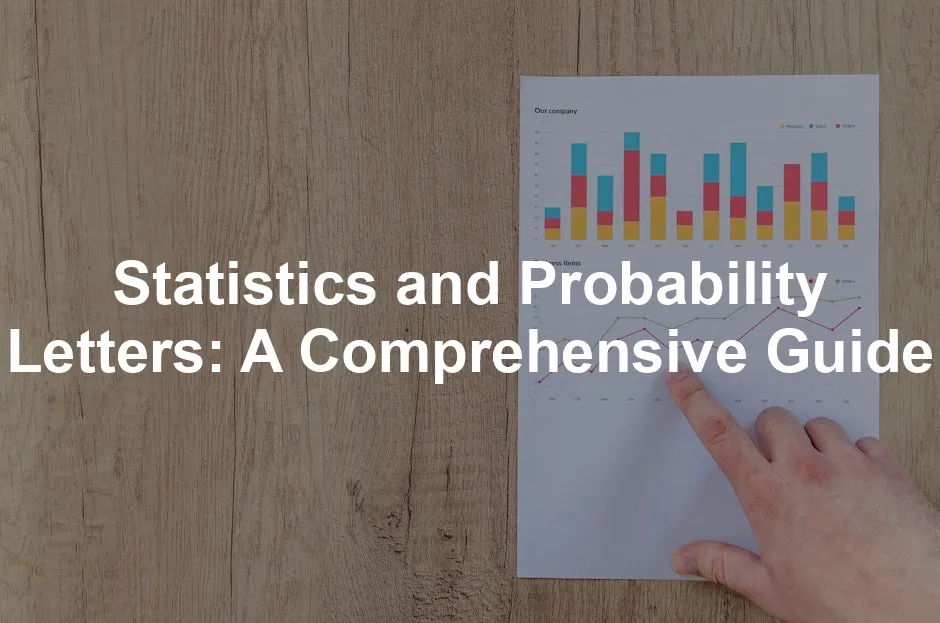Introduction
Statistics and Probability Letters is a renowned journal in the realm of statistical research. Since its inception, it has provided a vital platform for sharing innovative findings. The journal serves as a bridge between theory and application, making complex concepts more digestible for researchers and practitioners alike.
This article aims to give you a thorough understanding of Statistics and Probability Letters. We will explore its history, focus areas, and impact within the academic community. By doing so, we hope to illustrate why this journal holds a significant place in the field of statistics and probability. From groundbreaking research to concise communications, it plays a crucial role in advancing statistical knowledge.
So, why should you care about Statistics and Probability Letters? Well, if you’re a researcher, statistician, or simply someone intrigued by numbers, this journal is a treasure trove. It provides insights that enhance your understanding of statistical principles and their applications in real-world scenarios.
With its comprehensive scope and focus on rapid publication, Statistics and Probability Letters stands out. The journal not only addresses current trends but also highlights emerging methodologies in statistics and probability research.

Speaking of enhancing your statistical knowledge, you might want to check out “Naked Statistics: Stripping the Dread from the Data” by Charles Wheelan. This book makes statistics approachable and fun, stripping away the fear factor while delivering valuable insights.
Let’s embark on this informative journey to uncover the nuances of Statistics and Probability Letters!
History and Background of Statistics and Probability Letters
Origin and Establishment
Statistics and Probability Letters was founded in 1982, marking the beginning of an influential platform for statistical discourse. Initially, it aimed to alleviate the challenges researchers faced due to ever-growing literature and prolonged publication delays. Over the years, the journal has evolved significantly, adapting to the changing landscape of statistical research.
From its humble beginnings, Statistics and Probability Letters has grown into a highly respected journal. It maintains a focus on concise articles, ensuring that critical findings reach audiences quickly. This efficiency has led to its prominence in the field, making it a go-to source for both theoretical results and practical applications.
The journal has successfully published thousands of articles, contributing to various areas of statistics and probability. Its broad coverage includes essential topics like biostatistics and statistical bioinformatics. This diverse range ensures that readers gain insights from multiple perspectives, enriching their understanding of the subject.

Publisher and Editorial Standards
Elsevier serves as the publisher of Statistics and Probability Letters, maintaining high editorial standards. This partnership ensures the journal remains a leading resource in statistical research. The editorial board comprises experts who rigorously evaluate submitted manuscripts.
Quality, clarity, and originality are the cornerstones of the journal’s publication criteria. With stringent guidelines, the journal strives to publish only the most impactful research. This commitment to excellence has led to a respectable H-index of 73, reflecting the journal’s citation impact over the years.
Moreover, the journal fosters a culture of rapid publication. Authors can expect feedback on their submissions within three months. This swift review process encourages timely dissemination of research findings, keeping the academic community informed and engaged.
In summary, Statistics and Probability Letters has established itself as a key player in statistical research, thanks to its solid foundation and unwavering commitment to quality.
Scope and Focus Areas
Areas of Research Covered
Statistics and Probability Letters is a dynamic journal highlighting a myriad of research areas. It shines a spotlight on topics like biostatistics and statistical bioinformatics, which are crucial in understanding complex biological data. Imagine the impact of using statistics to decipher genetic information or track disease outbreaks. That’s the magic of biostatistics!
The journal also embraces innovative applications of statistical methods across various disciplines. Researchers utilize these techniques to solve real-world problems, from healthcare to environmental science. For instance, statisticians may analyze ecological data to assess the health of ecosystems. The journal’s commitment to broad coverage ensures that it addresses the diverse interests of the statistical community.
Statistical bioinformatics has emerged as a hot topic within the journal. This field combines statistics with biological data, allowing researchers to draw meaningful conclusions from massive datasets. It’s like finding a needle in a haystack but with a statistical twist! Papers often explore algorithms and methodologies that enhance data analysis in genetics, genomics, and proteomics.
Furthermore, the journal is a haven for theoretical research. It showcases groundbreaking theories that shape statistical methodologies. These theoretical advancements are crucial for developing new statistical tools, ensuring that the field continues to evolve. The integration of theory and application keeps the content relevant and engaging for readers.
Moreover, the journal does not shy away from interdisciplinary studies. It encourages submissions that apply statistical models to social sciences, economics, and engineering. This approach fosters collaboration among various fields, showing that statistics is not just confined to its own domain.

In summary, Statistics and Probability Letters covers an extensive range of research areas. Whether you’re interested in biostatistics, statistical bioinformatics, or innovative applications, this journal has something for everyone. It serves as a vital resource for researchers eager to stay informed about the latest advancements in statistics and probability.
If you’re curious about diving deeper into statistics, I highly recommend “Statistics for Data Science” by James D. Miller. This book is perfect for those looking to grasp the essentials of statistics while applying them to data science.
Types of Articles Published
Statistics and Probability Letters prides itself on publishing a variety of article types, catering to the fast-paced world of statistical research. The journal primarily focuses on concise communications. These articles are limited to six journal pages, making them quick to read yet packed with essential information. Think of them as bite-sized snacks of statistical wisdom!
Empirical results play a significant role in the journal’s offerings. Researchers are encouraged to present their findings clearly and concisely, allowing readers to grasp the significance of the results without wading through excessive detail. This approach ensures that critical insights reach the audience without delay, promoting rapid dissemination of knowledge.
Theoretical methods are also a key focus. The journal welcomes submissions that detail new statistical theories or methodologies. Authors often present innovative proofs or sketches, allowing for a streamlined review process. It’s all about making complex ideas accessible while providing enough detail for verification.
The journal is also open to computational results of considerable value. In an era where data is plentiful, sharing computational findings is essential. These articles demonstrate how statistical methods can be implemented to solve real-world problems, showcasing the practical applications of theory.
Moreover, the journal encourages authors to submit articles that may form part of larger studies. These initial findings can be later expanded into comprehensive papers. This flexibility fosters a collaborative environment, where researchers can build upon each other’s work, creating a rich tapestry of statistical knowledge.

In essence, Statistics and Probability Letters accepts a diverse array of articles. From concise communications to theoretical explorations, the journal remains committed to advancing the field of statistics and probability. It provides a platform for researchers to share their insights, ensuring that the community stays connected and informed.
Quartile Rankings
Quartile rankings provide a snapshot of a journal’s impact over time. These rankings categorize journals into four groups based on their citation metrics and relevance in their field. The highest tier, Q1, signifies top-tier journals that have a significant influence on research and scholarship. Conversely, Q4 represents journals with the least impact.
For Statistics and Probability Letters, these rankings have seen some ups and downs since its inception. Back in 1999, the journal was in Q3, which is respectable but not stellar. Fast forward to 2001, and it climbed to Q2, showcasing a growing reputation. However, from 2004 to 2010, it slipped back to Q3. It appears journals can have mood swings too!
By 2011, the journal bounced back to Q2 again, but this upward trajectory was not constant. It fluctuated between Q2 and Q3 from 2011 until 2023, as shown in the quartile data. For instance, in 2019 and 2020, it proudly sat in Q2. Yet, in recent years, it has settled back into Q3. This dance of rankings reflects the journal’s evolving impact in the statistical community, influenced by the quality of published research, citation practices, and emerging trends.
In summary, quartile rankings serve as a barometer for the journal’s academic standing. While Statistics and Probability Letters has experienced fluctuations, it remains a significant player in disseminating research in statistics and probability.

Impact Factor and SJR
The impact factor (IF) and SCImago Journal Rank (SJR) are key indicators of a journal’s academic prestige. The impact factor measures the average number of citations to recent articles published in a journal. Meanwhile, the SJR accounts for the prestige of the citing journals, providing a more nuanced view of a journal’s influence.
For Statistics and Probability Letters, the impact factor has shown a positive trend. In 2021, it was 0.718, climbing to 0.8 in 2022. The latest statistic for 2023 indicates it has reached an impressive 0.9. This upward trajectory signals increasing recognition and citation of articles published within the journal, which is fantastic news for authors aiming to boost their academic profiles.
Similarly, the SJR has seen fluctuations over the years. For instance, in 2021, it was recorded at 0.465, but this figure has gradually decreased over the subsequent years, landing at 0.448 in 2023. While this drop might sound alarming, it’s essential to understand that SJR values can reflect broader shifts in academia, such as changing citation patterns or the rise of new journals.
In conclusion, both the impact factor and SJR are vital metrics that reflect the academic standing of Statistics and Probability Letters. The increasing impact factor coupled with the recent SJR trends showcases the journal’s ongoing relevance and importance in the field of statistical research.

Submission Guidelines
Submitting an article to Statistics and Probability Letters is a straightforward process designed to ensure that original work receives the attention it deserves. To begin, authors must ensure their manuscript adheres to the journal’s strict requirements for originality, clarity, and quality. This means no recycled content from previous publications. If you’ve got a fresh idea or a groundbreaking result, this is the place to share it!
Once your paper is ready, you’ll submit it through the journal’s online platform. Here, you’ll fill out details like title, abstract, and keywords. Don’t forget to double-check those references! After submission, the journal aims to provide the first review of your manuscript within three months. This rapid turnaround is a big plus for researchers eager to see their work published and cited.
Keep in mind that articles are limited to six pages. This constraint encourages authors to be concise and clear, getting to the heart of their findings without fluff. If your study is part of a larger work, that’s perfectly fine! You can submit key results now and expand on them later in a full-length article.
In summary, the submission process is designed to be efficient and author-friendly, ensuring that quality research gets published quickly. So, polish your manuscript, follow the guidelines, and you might just see your work in print!

Accessibility of Articles
Accessing articles from Statistics and Probability Letters is designed to be user-friendly, catering to both individual readers and institutions. If you’re part of a subscribing institution, you’re in luck! You can access full-text articles via platforms like ScienceDirect without any extra cost. Just log in through your institution’s library portal, and voilà—instant access to a treasure trove of statistical wisdom.
For those without institutional access, fear not! Individual subscriptions are available, allowing you a pathway to the latest research. You can purchase individual articles or opt for a subscription that suits your reading habits. Keep in mind that this option incurs a fee, but it’s a worthy investment for serious researchers or statistical enthusiasts.
In some cases, you might find articles available for free as part of promotional offerings or open-access initiatives. Always check the journal’s website for any special access options or discounts.
In summary, whether you’re a student, researcher, or just a curious mind, Statistics and Probability Letters provides multiple avenues to dive into cutting-edge statistical research. So, grab your coffee and start reading!

Notable Articles and Research Trends
Recent articles in Statistics and Probability Letters have made waves in the statistical community. A notable paper, “A stereographic test of spherical uniformity,” delves into innovative statistical techniques that could reshape our understanding of spatial data. This study is significant because it addresses practical applications in fields like geology and meteorology, where understanding the uniformity of data on a sphere is crucial.
Another impactful article, “Population-level information for improving quantile regression efficiency,” tackles the efficiency of statistical methods used in analyzing population data. This research highlights the importance of enhancing statistical tools, making it easier for researchers to extract valuable insights from large datasets. It’s like finding the perfect pair of shoes in a crowded store—just when you thought it was impossible!
Moreover, the journal recently published a study on “D-optimal designs for a multidimensional second-degree polynomial model.” This article emphasizes the need for optimal experimental designs, showcasing how strategic planning can lead to more accurate results. Such studies not only advance theoretical knowledge but also provide practical methodologies for researchers in various fields.
These articles reflect current trends toward innovation and efficiency in statistical methodologies. As the field evolves, it’s clear that Statistics and Probability Letters serves as a vital platform for disseminating groundbreaking research. The implications of these findings extend beyond academia, influencing real-world applications in healthcare, finance, and environmental studies.

International Collaboration and Diversity
International collaboration is a hallmark of successful research, and Statistics and Probability Letters is no exception. Over the years, the percentage of international authors contributing to the journal has fluctuated, with notable peaks. In 2004, for example, the rate reached an impressive 28.64%. This trend highlights the journal’s global appeal, drawing contributions from statisticians around the world.
However, recent data indicates a decline in international collaboration, dropping to 15.63% in 2023. This dip could suggest a shift in research dynamics, possibly due to increased competition among journals or the rise of local publications. Despite this decline, the journal remains a beacon for international scholarly exchange.
In terms of diversity, the percentage of female authors has also shown variability. In 2020, female authors constituted 29.24% of submissions, a promising figure for gender representation in statistics. Yet, this percentage fell to 22.45% in 2023, reflecting ongoing challenges in achieving gender parity. Increasing female representation is crucial for fostering diverse perspectives in research.
The journal’s commitment to inclusivity is evident, as it actively encourages submissions from underrepresented groups. This focus not only enriches the content but also inspires future generations of statisticians to contribute to the field. Overall, while the landscape of international collaboration and diversity presents challenges, Statistics and Probability Letters continues to champion a global approach to statistical research.

Conclusion
Statistics and Probability Letters plays a pivotal role in advancing research findings in statistics and probability. This journal is not just a collection of articles; it’s a platform that bridges theoretical knowledge with practical application. The significance of quick publication and concise communication cannot be overstated. Researchers are under pressure to share their findings promptly, and this journal meets that need beautifully.
By delivering timely insights, Statistics and Probability Letters helps shape the direction of statistical research. It encourages innovative methodologies, ensuring that the field remains dynamic and relevant. The journal’s commitment to quality is reflected in its stringent editorial standards and its ability to attract high-quality submissions.
Looking to the future, the journal is poised for further growth. As statistical research becomes increasingly interdisciplinary, there’s potential for more articles that blend statistics with fields like data science and machine learning. This evolution reflects broader trends in academia, where collaboration across disciplines is becoming the norm.
Moreover, the journal is likely to enhance its focus on open-access models. With the increasing demand for accessible research, Statistics and Probability Letters could pave the way for greater transparency in statistical findings. This shift would benefit not only researchers but also practitioners in various sectors who rely on statistical insights.
In summary, Statistics and Probability Letters is essential for anyone interested in the latest developments in statistics and probability. Its commitment to rapid publication, diverse contributions, and high-quality research makes it a cornerstone in the academic landscape. As we look ahead, this journal will undoubtedly continue to influence the trajectory of statistical research, ensuring that it remains a vital resource for the global research community.

FAQs
What is Statistics and Probability Letters?
Statistics and Probability Letters is a leading journal dedicated to the publication of high-quality research in the fields of statistics and probability. Established in 1982, it focuses on concise articles that present significant findings and methodologies, ensuring rapid dissemination of knowledge among researchers.
How can I submit an article to the journal?
To submit an article to Statistics and Probability Letters, authors must follow the journal’s submission guidelines. Manuscripts should be original, clear, and concise, limited to six pages. Submissions are made through the journal’s online platform, and authors can expect a review within three months.
What are the benefits of publishing in Statistics and Probability Letters?
Publishing in Statistics and Probability Letters offers numerous advantages. Authors benefit from rapid publication, a broad readership, and the opportunity to contribute to high-impact research. The journal’s focus on concise communication ensures that critical findings reach the audience quickly, enhancing visibility and citation potential.
How can I access articles from Statistics and Probability Letters?
Accessing articles from Statistics and Probability Letters is easy. Full-text articles are available to subscribers through platforms like ScienceDirect. Individual subscriptions can be purchased for personal access, and some articles may be available for free during promotional periods or as part of open-access initiatives.
For a deeper dive into the significance of statistical learning and its applications, check out an introduction to statistical learning with python book length.
Also, if you’re looking to expand your skills in R programming, consider grabbing “R Programming for Data Science” by Hadley Wickham. This book is a fantastic resource that guides you through the essentials of programming in R, making it easier to tackle statistical challenges.
Please let us know what you think about our content by leaving a comment down below!
Thank you for reading till here 🙂
Understanding the impact factors in medical statistics is crucial for researchers. Learn more about this topic in statistics in medicine impact factor.
And don’t forget to keep your data organized! The Logitech MX Master 3 Mouse is perfect for efficiently navigating your data analysis tasks.
All images from Pexels




